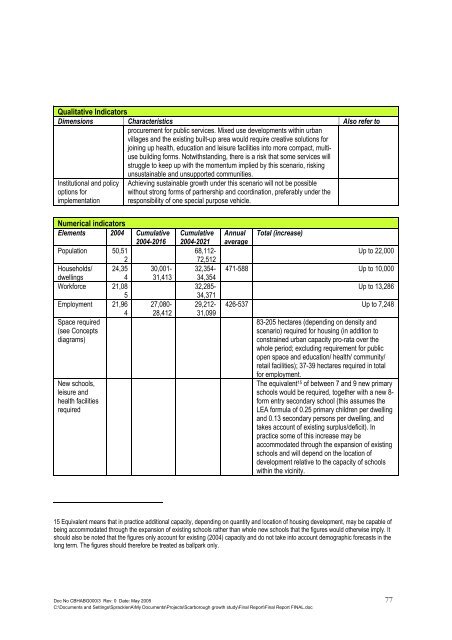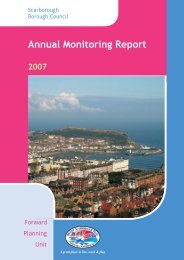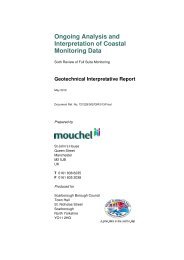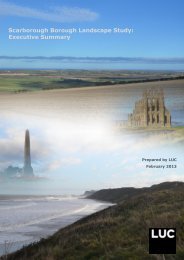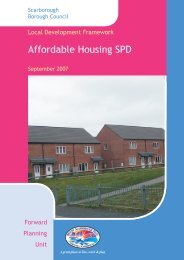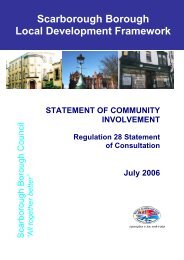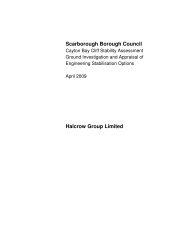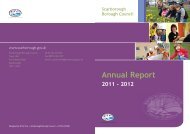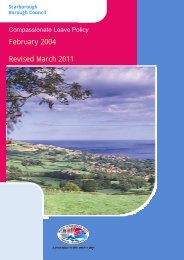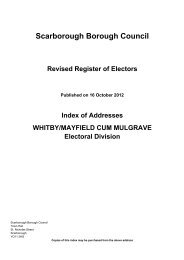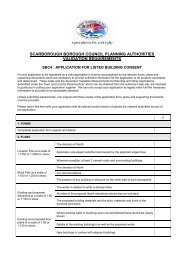Growth of Scarborough Study - Scarborough Borough Council
Growth of Scarborough Study - Scarborough Borough Council
Growth of Scarborough Study - Scarborough Borough Council
Create successful ePaper yourself
Turn your PDF publications into a flip-book with our unique Google optimized e-Paper software.
Qualitative Indicators<br />
Dimensions Characteristics Also refer to<br />
procurement for public services. Mixed use developments within urban<br />
villages and the existing built-up area would require creative solutions for<br />
joining up health, education and leisure facilities into more compact, multiuse<br />
building forms. Notwithstanding, there is a risk that some services will<br />
struggle to keep up with the momentum implied by this scenario, risking<br />
unsustainable and unsupported communities.<br />
Institutional and policy<br />
options for<br />
implementation<br />
Achieving sustainable growth under this scenario will not be possible<br />
without strong forms <strong>of</strong> partnership and coordination, preferably under the<br />
responsibility <strong>of</strong> one special purpose vehicle.<br />
Numerical indicators<br />
Elements 2004 Cumulative<br />
2004-2016<br />
Population 50,51<br />
2<br />
Households/ 24,35<br />
dwellings<br />
4<br />
Workforce 21,08<br />
5<br />
Employment 21,96<br />
4<br />
Space required<br />
(see Concepts<br />
diagrams)<br />
New schools,<br />
leisure and<br />
health facilities<br />
required<br />
Cumulative<br />
2004-2021<br />
68,112-<br />
72,512<br />
32,354-<br />
34,354<br />
32,285-<br />
34,371<br />
29,212-<br />
31,099<br />
30,001-<br />
31,413<br />
27,080-<br />
28,412<br />
Annual<br />
average<br />
Total (increase)<br />
Up to 22,000<br />
471-588 Up to 10,000<br />
Up to 13,286<br />
426-537 Up to 7,248<br />
83-205 hectares (depending on density and<br />
scenario) required for housing (in addition to<br />
constrained urban capacity pro-rata over the<br />
whole period; excluding requirement for public<br />
open space and education/ health/ community/<br />
retail facilities); 37-39 hectares required in total<br />
for employment.<br />
The equivalent 15 <strong>of</strong> between 7 and 9 new primary<br />
schools would be required, together with a new 8-<br />
form entry secondary school (this assumes the<br />
LEA formula <strong>of</strong> 0.25 primary children per dwelling<br />
and 0.13 secondary persons per dwelling, and<br />
takes account <strong>of</strong> existing surplus/deficit). In<br />
practice some <strong>of</strong> this increase may be<br />
accommodated through the expansion <strong>of</strong> existing<br />
schools and will depend on the location <strong>of</strong><br />
development relative to the capacity <strong>of</strong> schools<br />
within the vicinity.<br />
15 Equivalent means that in practice additional capacity, depending on quantity and location <strong>of</strong> housing development, may be capable <strong>of</strong><br />
being accommodated through the expansion <strong>of</strong> existing schools rather than whole new schools that the figures would otherwise imply. It<br />
should also be noted that the figures only account for existing (2004) capacity and do not take into account demographic forecasts in the<br />
long term. The figures should therefore be treated as ballpark only.<br />
Doc No CBHABG000/3 Rev: 0 Date: May 2005 77<br />
C:\Documents and Settings\SpracklenA\My Documents\Projects\<strong>Scarborough</strong> growth study\Final Report\Final Report FINAL.doc


